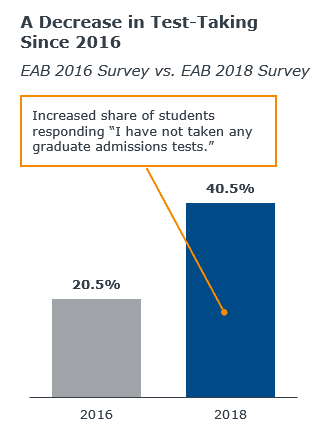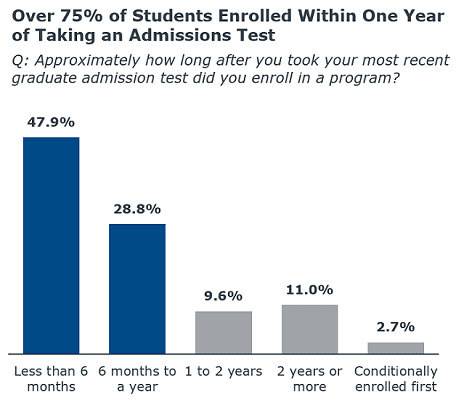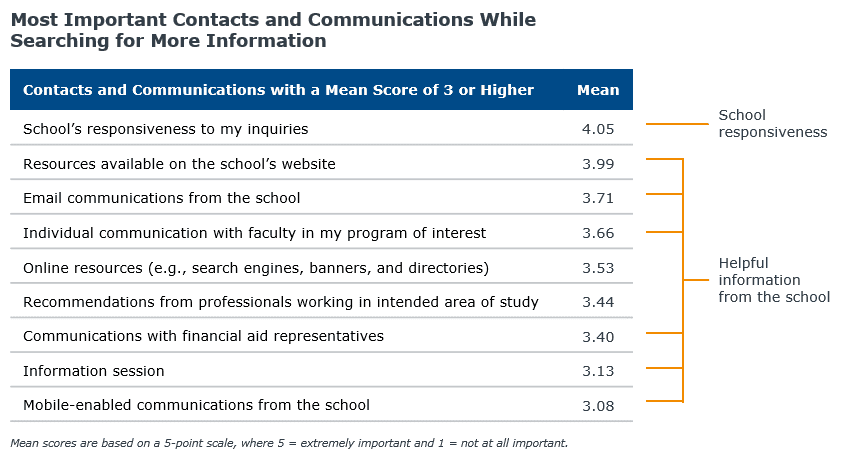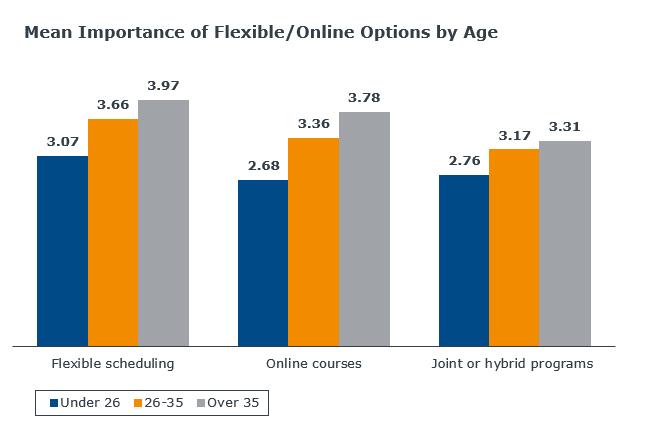Over the past year, I’ve visited over 50 different college campuses. While these visits have given me the chance to hear about adult learner recruitment issues from many different campus leaders around the country, there’s one critical group that I don’t get to hear from as often—the students.
Which is why I couldn’t wait to get my hands on the results of our new adult learner survey to hear what students had to say, in their own words. For this research, we surveyed nearly 1,000 adult learners, which we defined as current and prospective students of graduate, online, certificate, and undergraduate degree completion programs. Their answers revealed many surprising findings—and ones that have significant implications for enrollment and recruitment leaders.
Insight #1: Adult learners are increasingly pragmatic
Our data shows that today’s adult learners are interested in streamlining the graduate school search and application processes for themselves whenever possible. For example, we found that 43% of applicants had applied only to a single school and that most (53%) spent less than two hours on each application.
Similarly, when we asked current and prospective students about which graduate admissions tests they had taken, we found that 4 in 10 had not taken any admissions tests. This was twice as many students saying that they hadn’t taken tests as in our 2016 survey, indicating a clear downward trend in test-taking, and one that aligns with national decreases in GRE and GMAT volume over the past few years.

Our survey also showed that most adult learners are approaching the application process with a very deliberate plan in mind. 69% of test-takers knew where they would apply before taking a test and 77% enrolled within one year of taking the exam. Both findings indicate that adult learners are taking tests only after they’ve done enough research to feel confident about their top choices.

Recommendation: Reach prospects early through newer targeting methods
While influencing adult learners’ plans after they’ve taken a test is possible with the right targeting, messaging, and marketing strategy—this data suggests that it is important for institutions to reach adult learners as early as possible, ideally before they’ve taken an admissions test.
By engaging with students early, colleges and universities can ensure that they’re building awareness and affinity with prospects from the moment they start researching schools, rather than after they have formulated a top-choice or are pre-disposed to a specific plan.
Two important marketing strategies that can allow schools to reach prospects early are digital advertising and paid search—but these can be challenging to do at scale in a cost-effective way without the right resources. At EAB Adult Learner Recruitment, we help schools deploy these (and other) proven tactics—many borrowed from best practices in consumer analytics—to help build awareness and engagement early.
Insight #2: Adult learners are digital consumers—with high expectations for recruitment
The data in our survey suggests that today’s adult learners have high expectations of their interactions with graduate schools, likely influenced by their daily interactions with other brands. With the rise of services like Uber, Venmo, and Amazon Prime, all of us—including adult learners—have heightened expectations for the speed and convenience with which we can access useful information and complete tasks.
In terms of recruitment, this was reflected in the level of responsiveness and accessibility of information that students demand from schools. Survey participants who either planned to enroll or who were currently enrolled were asked to rank the importance of a variety of contacts and communications in their program search. The factor that was named as most important was a school’s responsiveness to the student’s inquiries, with a mean score of 4.05, or “very important.”
Other top responses to this question showed that adult learners expect schools to not only respond quickly, but also to understand prospects’ intent and to provide the information that they’re looking for, when they they’re looking for it. This is illustrated in the second-most important response, the resources available on the school’s website, and the third-most important response, email communications from the school.

Recommendation: Tailor your marketing to prospective student intent
Based on these findings, schools need to be creating a marketing strategy that focuses on providing prospective students the right information at the right time. To do so, create a multi-channel communications plan that’s tailored to students’ questions and intent at each stage of recruitment.
Marketing to intent can also include providing robust resources on your website for students who are researching your program. Examples of commonly sought-after information include details about program specifications like time to degree, schedule options, and cost, as well as information about program benefits, including skills gained and career outcomes. Be sure that you’re following SEO best practices so that prospects can effectively find this information from search engines.
Insight #3: Older and younger adult learners value different program factors
When we asked adult learners what factors they consider most important when choosing a program, there were clear differences by age. Older adult learners, on average, placed more importance on factors related to flexibility, such as online courses, flexible scheduling, and hybrid online/in-class programs. Younger adult learners cared more about factors related to campus life and placed more weight on factors like school size, surrounding community, and physical facilities. Given that older students are more likely to have children and be more established in their career, these findings aren’t particularly surprising. However, the clear trend in the data underscores the need for schools to recognize that older and younger students likely aren’t seeking the same experience.

Recommendation: Adapt your marketing messaging based on prospective student characteristics
Ensure that the way you’re presenting your program closely aligns with the characteristics and preferences of your target audience. Are they mostly younger students, straight out of college? Then you may want to play up the on-campus experience and the community that students can take part in. Are they farther out of college and more established in their careers? Then you’ll want to try out messaging that emphasizes your program features that allow for school-life balance. While these trends can be an important starting place, it’s important to conduct tests to determine which messages actually perform best with your prospects.
By reaching students early and creating a strategy that aligns with prospective students’ motivations and preferences, adult learner and graduate education programs can ensure that they’re well-positioned for growth in 2019 and beyond.


